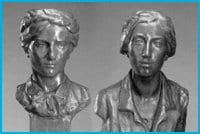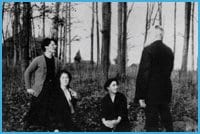
'ACTS OF LOVE.' The portrait busts The Girls made of each other (Wyle on the left; Loring on the right). Credit: (NATIONAL GALLERY OF CANADA)
These days tolerance and diversity are part of Toronto’s DNA. But, as Elspeth Cameron’s latest biography reminds us, it hasn’t always been that way. And Beauty Answers tells the story of influential sculptors Frances Loring and Florence Wyle, who moved here from New York in 1911. The Toronto they encountered was conservative and pious — a far cry from the bohemian Greenwich Village they had left behind. The young artists turned plenty of heads in their new homeland: Wyle sported a short haircut and dressed in men’s clothing while Loring spoke with a deep voice.
They were probably a lesbian couple, though not officially. Their euphemistic nickname, “The Girls,” suggests an open secret, but any personal correspondence between them was lost or destroyed. Loring and Wyle were together for 55 years and produced around 500 sculptures — a body of work that helped define Canadian art. But since their deaths in 1968 both women have largely been forgotten, despite the enduring presence of their work in many of Ontario’s public spaces. Cameron’s biography brings the eccentric pair to life, warts and all.
The couple’s unconventional studio-home — a converted church in Rosedale — was barely habitable when they bought it in 1920. Their new neighbours gawped as the two women unloaded sculpture after sculpture, some of them nudes. “They thought it a peculiar thing that two young women should live together,” Loring noted. But she was characteristically defiant: “You can’t go through life worrying about what the public’s going to think of you.” Far from alienating them, The Girls’ uncompromising attitude made them Toronto characters. Dressed in men’s shoes and moth-eaten berets, the couple could often be spotted walking their dogs, Samson and Delilah, around Rosedale ravine.
That same individuality also attracted Toronto’s burgeoning art community. At a time when sculpture was a male institution The Girls defied convention by working hard and producing great work. The gatherings they held at their studio-home — christened “The Church” — were Canada’s version of a Parisian salon. Their friends included well-known photographers Charles Ashley and James Crippen (a homosexual couple known as The Boys) and the Group of Seven’s AY Jackson. Jackson was a particular fan of their work, claiming that Loring and Wyle’s war worker sculptures, “make him wish to knock down all the statues in Toronto and let [Florence and Frances] replace them with anything [they] wish.”
And Toronto listened. As well as numerous war memorials and fountains The Girls received commissions for important national monuments like Loring’s Parliament Hill statue of Sir Robert Borden and their popular Queen Elizabeth monument, formerly at the entrance to the QEW. The Art Gallery of Ontario owns some 200 of their sculptures and they were founding members of the Sculptors’ Society of Canada. Remarkably, despite poverty induced by the Depression and two world wars, The Girls never accepted teaching positions or charity. And they refused to compromise their neoclassical style in favour of more modern ideas — a move that resulted in their gradual fall from grace. The purpose of art, they believed, was to bring beauty into an unforgiving world. “The evolution toward the fuller consciousness of beauty is slow,” said Loring, “but once it has captured your soul, nothing else will do.”
Although undoubtedly beautiful, The Girls’ work didn’t exactly set the world on fire. They both rejected Modernism, especially figurative sculptors like Henry Moore. Their move to repressed Toronto from vibrant Greenwich Village probably made their work more boring and, try as she might, Cameron doesn’t engender a love for their work. Instead, the reader is left wondering what The Girls would have achieved if they’d remained in the more experimental environment of Greenwich Village. Their work is certainly important, but it’s their colourful personalities that bring this biography to life.
Although Cameron sometimes obscures her subjects beneath too much historical detail her treatment of their possible lesbianism is satisfyingly extensive. She’s at pains to point out the evidence of attachments to men, but balances it with lesbian readings of their life and work. She sets The Girls squarely in their historical context, when theories of sexual inversion made declarations of homosexuality problematic. We know they shared a bedroom for most of their lives but we just can’t know whether or not the relationship was sexual. “Theirs was the closest emotional relationship either of them ever had,” writes Cameron. “In Platonic terms, they were soulmates, as complementary to each other as Yin and Yang.” Cameron resists the temptation to label their lives as “lesbian” or “feminist,” and that is certainly to the book’s credit. Here are two women — creative, unfeminine, outspoken women no less — who challenged the establishment by never compromising their individuality, in their art or their private lives.
Stone angels
There’s more to local queer sculpture than the Alexander Wood statue at the corner of Church and Alexander streets. Loring and Wyle left a legacy of works scattered across Ontario. Here’s where to find them.
Loring-Wyle Parkette, northeast corner of St Clair Ave E and Mount Pleasant Rd. This Rosedale park is situated just one block north of Loring and Wyle’s studio-home. It contains the busts The Girls made of each other — Loring looks toward Wyle, who gazes north up Mount Pleasant — as well as Wyle’s The Harvester and Young Girl, plus a commemorative plaque.
Memorial to Nurse Edith Cavell by Wyle, Toronto General Hospital, 585 University Ave. This early work stands in the driveway leading to the Robert R McEwen Atrium, embedded in freestanding concrete. A wreath was mysteriously added to the sculpture and never removed by the authorities. “If I’d intended it,” commented Wyle, “I’d have done it myself when I made the thing.”
Mother and Child by Wyle, 32 Heath St W. Wyle’s well-known depiction of maternal love now takes pride of place outside the Canadian Mothercraft Society in Deer Park, near Yonge and St Clair.
The Queen Elizabeth Monument by Loring, Wyle and WL Somerville, Sir Casimir Gzowski Park. For many years the famous stone lion and column guarded the Eastern entrance to the QEW. It was a popular landmark known by locals as “The Monument.” In 1974 it was moved to the nearby park on Lakeshore Blvd W, where it remains today.
Loring-Wyle Studio, 110 Glenrose Ave. The Girls’ beloved Church is still there, now labelled with a blue Ontario Historical Plaque. It’s a private home owned by Bobby and Marlie Sniderman, the son and daughter-in-law of Sam the Record Man. Bobby grew up in the area and was one of many locals who visited “The Clay Ladies” as a child.
The Canadian Coat of Arms by Loring and Wyle, Niagara Falls. Take a closer look at the Canadian customs house while crossing the Rainbow Bridge back home and you’ll notice a coat of arms. It’s the combined handiwork of both sculptors and was completed in 1939.
Sir Robert Borden by Loring, Parliament Hill, Ottawa. Loring’s 1957 masterpiece still stands tall at Parliament Hill. At its unveiling — attended by the then prime minister and assembled press — Loring said she “felt like a singer at her first concert.”

 Why you can trust Xtra
Why you can trust Xtra


